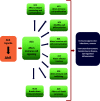Consensus on the Key Characteristics of Immunotoxic Agents as a Basis for Hazard Identification
- PMID: 36201310
- PMCID: PMC9536493
- DOI: 10.1289/EHP10800
Consensus on the Key Characteristics of Immunotoxic Agents as a Basis for Hazard Identification
Abstract
Background: Key characteristics (KCs), properties of agents or exposures that confer potential hazard, have been developed for carcinogens and other toxicant classes. KCs have been used in the systematic assessment of hazards and to identify assay and data gaps that limit screening and risk assessment. Many of the mechanisms through which pharmaceuticals and occupational or environmental agents modulate immune function are well recognized. Thus KCs could be identified for immunoactive substances and applied to improve hazard assessment of immunodulatory agents.
Objectives: The goal was to generate a consensus-based synthesis of scientific evidence describing the KCs of agents known to cause immunotoxicity and potential applications, such as assays to measure the KCs.
Methods: A committee of 18 experts with diverse specialties identified 10 KCs of immunotoxic agents, namely, 1) covalently binds to proteins to form novel antigens, 2) affects antigen processing and presentation, 3) alters immune cell signaling, 4) alters immune cell proliferation, 5) modifies cellular differentiation, 6) alters immune cell-cell communication, 7) alters effector function of specific cell types, 8) alters immune cell trafficking, 9) alters cell death processes, and 10) breaks down immune tolerance. The group considered how these KCs could influence immune processes and contribute to hypersensitivity, inappropriate enhancement, immunosuppression, or autoimmunity.
Discussion: KCs can be used to improve efforts to identify agents that cause immunotoxicity via one or more mechanisms, to develop better testing and biomarker approaches to evaluate immunotoxicity, and to enable a more comprehensive and mechanistic understanding of adverse effects of exposures on the immune system. https://doi.org/10.1289/EHP10800.
Figures




Similar articles
-
Consensus on the key characteristics of metabolism disruptors.Nat Rev Endocrinol. 2025 Apr;21(4):245-261. doi: 10.1038/s41574-024-01059-8. Epub 2024 Nov 29. Nat Rev Endocrinol. 2025. PMID: 39613954 Review.
-
Key Characteristics of Cardiovascular Toxicants.Environ Health Perspect. 2021 Sep;129(9):95001. doi: 10.1289/EHP9321. Epub 2021 Sep 24. Environ Health Perspect. 2021. PMID: 34558968 Free PMC article.
-
Proposed Key Characteristics of Female Reproductive Toxicants as an Approach for Organizing and Evaluating Mechanistic Data in Hazard Assessment.Environ Health Perspect. 2019 Jul;127(7):75001. doi: 10.1289/EHP4971. Epub 2019 Jul 19. Environ Health Perspect. 2019. PMID: 31322437 Free PMC article.
-
The key characteristics concept.Curr Opin Toxicol. 2025 Mar;41:100515. doi: 10.1016/j.cotox.2024.100515. Curr Opin Toxicol. 2025. PMID: 40270588 Free PMC article.
-
Application of the Key Characteristics of Carcinogens to Bisphenol A.Int J Toxicol. 2024 May-Jun;43(3):253-290. doi: 10.1177/10915818231225161. Epub 2024 Jan 10. Int J Toxicol. 2024. PMID: 38204208 Review.
Cited by
-
In Vitro Effects of Cypermethrin and Glyphosate on LPS-Induced Immune Cell Activation.Life (Basel). 2023 Dec 29;14(1):62. doi: 10.3390/life14010062. Life (Basel). 2023. PMID: 38255676 Free PMC article.
-
Consensus on the key characteristics of metabolism disruptors.Nat Rev Endocrinol. 2025 Apr;21(4):245-261. doi: 10.1038/s41574-024-01059-8. Epub 2024 Nov 29. Nat Rev Endocrinol. 2025. PMID: 39613954 Review.
-
Application and interpretation of immunophenotyping data in safety and risk assessment.Front Toxicol. 2024 Oct 4;6:1409365. doi: 10.3389/ftox.2024.1409365. eCollection 2024. Front Toxicol. 2024. PMID: 39430110 Free PMC article. Review.
-
A systematic evidence map of chronic inflammation and immunosuppression related to per- and polyfluoroalkyl substance (PFAS) exposure.Environ Res. 2023 Mar 1;220:115188. doi: 10.1016/j.envres.2022.115188. Epub 2022 Dec 30. Environ Res. 2023. PMID: 36592815 Free PMC article. Review.
-
Suppression of the T-dependent antibody response following oral exposure to selected polycyclic aromatic compounds in B6C3F1/N mice.Front Toxicol. 2025 Mar 6;7:1558639. doi: 10.3389/ftox.2025.1558639. eCollection 2025. Front Toxicol. 2025. PMID: 40115130 Free PMC article.
References
-
- Atwood ST, Lunn RM, Garner SC, Jahnke GD. 2019. New perspectives for cancer hazard evaluation by the report on carcinogens: a case study using read-across methods in the evaluation of haloacetic acids found as water disinfection by-products. Environ Health Perspect 127(12):125003, PMID: , 10.1289/EHP5672. - DOI - PMC - PubMed
-
- IARC (International Agency for Research on Cancer). 2019. Preamble, IARC Monographs on the Evaluation of Carcinogenic Risks to Humans. Amended January 2019. https://monographs.iarc.fr/wp-content/uploads/2019/07/Preamble-2019.pdf [accessed 18 February 2021].
-
- OEHHA (California Office of Environmental Health Hazard Assessment). 2017. Evidence on the Carcinogenicity of Coumarin. Proposition 65. August 2017. Sacramento, CA: OEHHA. https://oehha.ca.gov/media/downloads/crnr/coumarinhid.pdf [accessed 20 February 2021].

